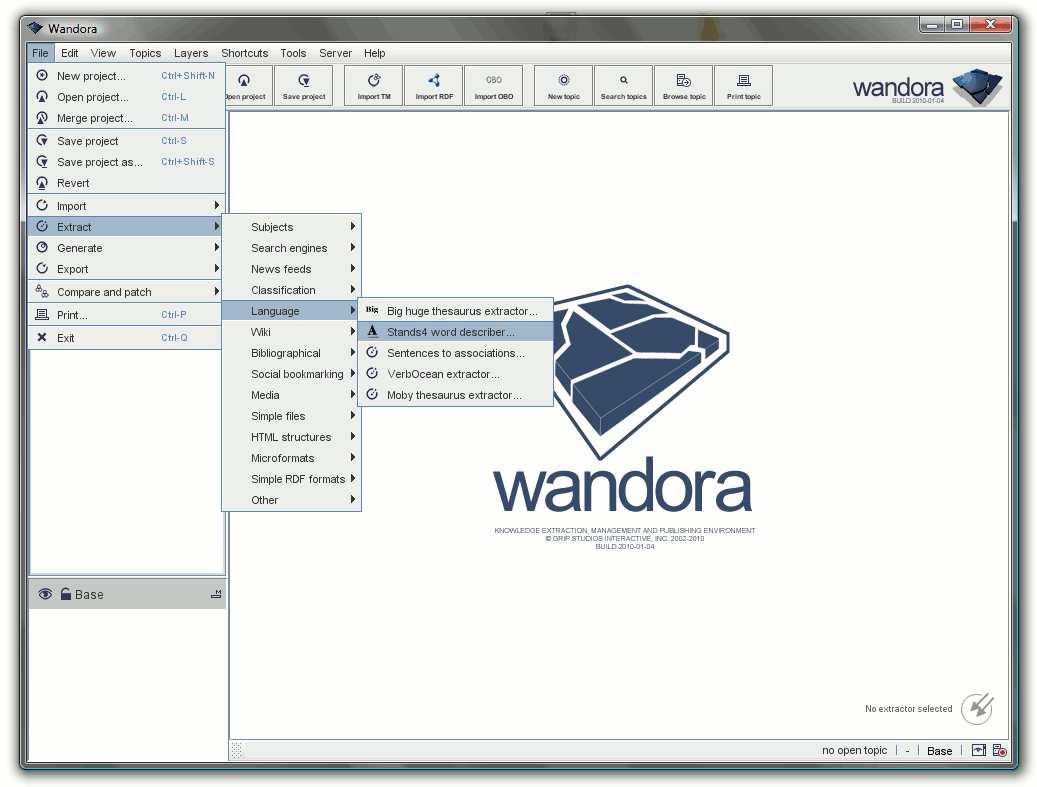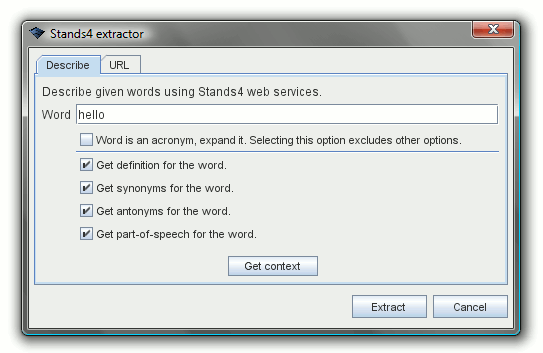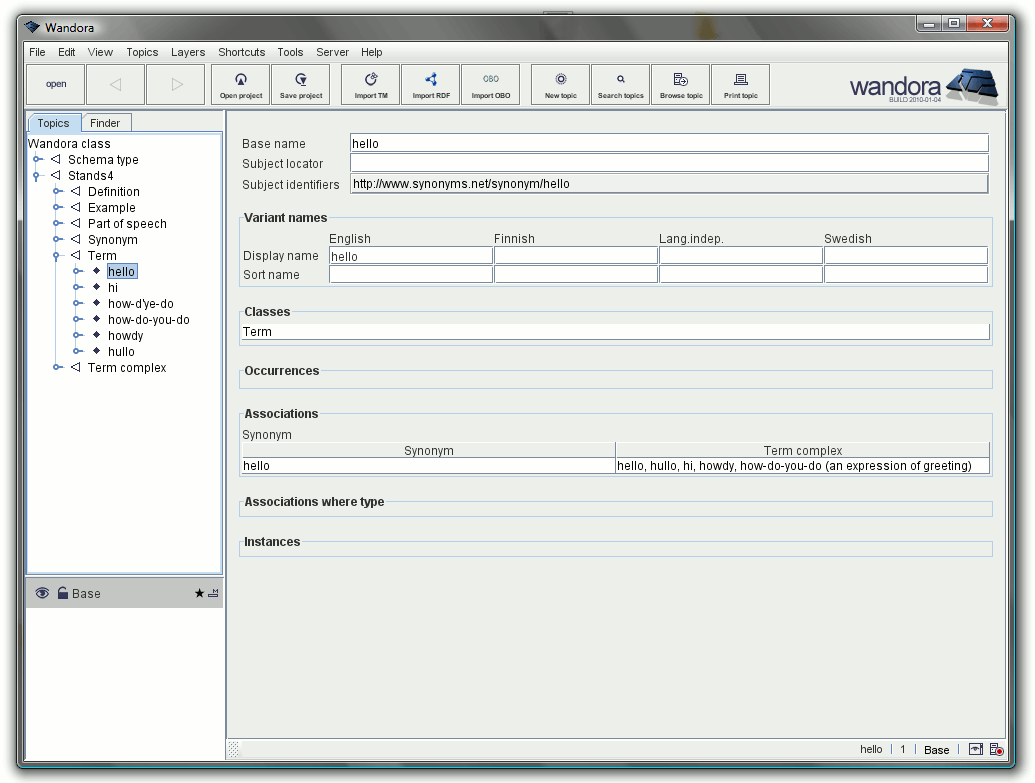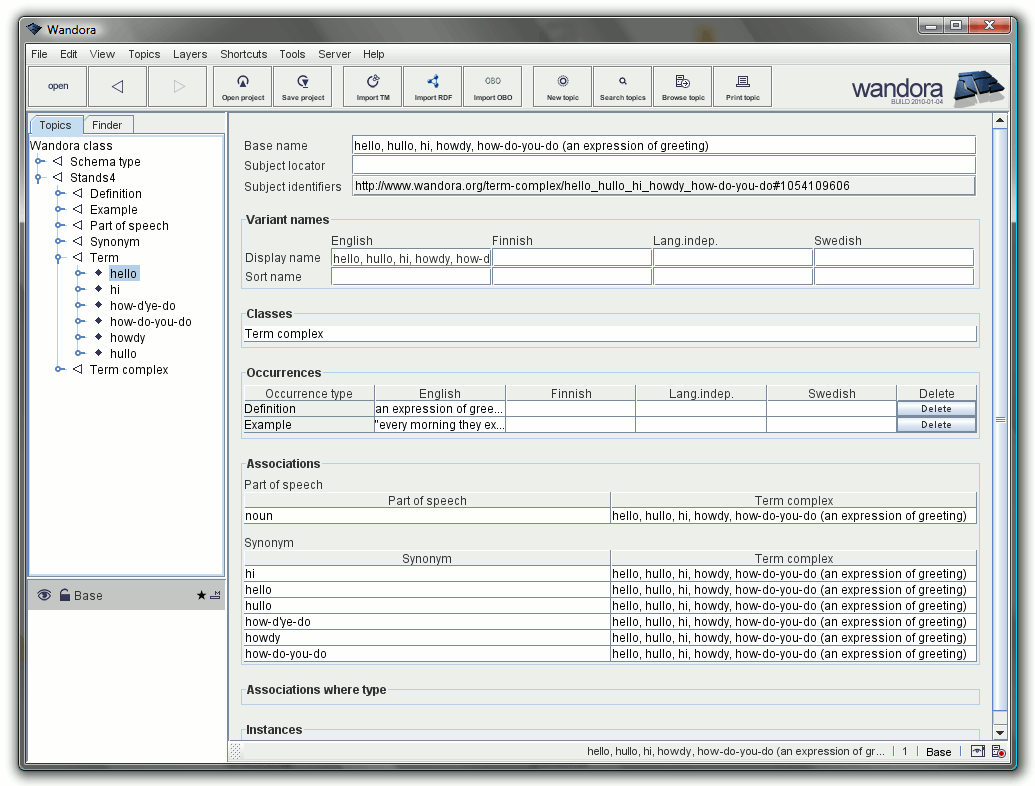Stands4 word describer
| Line 1: | Line 1: | ||
| − | Wandora's '''Extract > Language > Stands4 word describer''' is used to describe given word with associations and occurrences provided by external web service [http://www.abbreviations.com/ STANDS4 API]. STANDS4 API provider, STANDS4 LLC is a leading provider of free online reference resources, serving millions of unique visitors worldwide with genuine content through its network of reference websites and content partners. Wandora's word describer requests a key for STANDS4 API. You can request your personal apikey | + | Wandora's '''Extract > Language > Stands4 word describer''' is used to describe given word with associations and occurrences provided by external web service [http://www.abbreviations.com/ STANDS4 API]. STANDS4 API provider, STANDS4 LLC is a leading provider of free online reference resources, serving millions of unique visitors worldwide with genuine content through its network of reference websites and content partners. Wandora's word describer requests a key for STANDS4 API. You can request your personal apikey [http://www.abbreviations.com/api.asp here]. Wandora doesn't store your apikey between use sessions. |
Describing associations are synonym, antonyms, and part-of-speech. Describing occurrences are definition and example. '''Stands4 word describer''' can also expand acronyms. What is interesting in STANDS4 descriptions, is the use of '''concepts''' or '''term-complexes''' as they are called in Wandora extractions. The idea is that describing, say a term '''hello''' doesn't describe generated term topic '''hello''' with direct associations to it's synonyms such as '''hi''' or '''howdy''' but a concept of '''hello, hullo, hi, howdy, how-do-you-do (an expression of greeting)''', and this concept is then associated to all synonyms. As noted above, Wandora calls these concepts as term-complexes due to their naming. | Describing associations are synonym, antonyms, and part-of-speech. Describing occurrences are definition and example. '''Stands4 word describer''' can also expand acronyms. What is interesting in STANDS4 descriptions, is the use of '''concepts''' or '''term-complexes''' as they are called in Wandora extractions. The idea is that describing, say a term '''hello''' doesn't describe generated term topic '''hello''' with direct associations to it's synonyms such as '''hi''' or '''howdy''' but a concept of '''hello, hullo, hi, howdy, how-do-you-do (an expression of greeting)''', and this concept is then associated to all synonyms. As noted above, Wandora calls these concepts as term-complexes due to their naming. | ||
== Example == | == Example == | ||
| + | |||
| + | In this example Wandora user describes a word '''hello''' using Wandora's '''Stands4 word describer'''. First, user start the describer selecting menu option '''Extract > Language > Stands4 word describer''' as shown below. | ||
| + | |||
| + | [[Image:Stands4api_example1.gif|center]] | ||
| + | |||
| + | Wandora opens up a dialog where user can enter the described word and options for description process. | ||
| + | |||
| + | [[Image:Stands4api_example2.gif|center]] | ||
| + | |||
| + | Then user clicks Extract button. If user is describing his/her first word Wandora request an apikey for [http://www.abbreviations.com/ STANDS4 API]. You can request your personal apikey [http://www.abbreviations.com/api.asp here]. Wandora performs an api call, receives a description for the '''hello''', and transforms the description to Topic Maps structures, topics and associations. | ||
| + | |||
| + | Next Wandora user opens extracted topic '''hello''' as shown below. | ||
| + | |||
| + | [[Image:Stands4api_example3.gif|center]] | ||
| + | |||
| + | '''Hello''' topic is associated to a term-complex called '''hello, hullo, hi, howdy, how-do-you-do (an expression of greeting)''' representing an expression of greeting. User double clicks the topic and it is opened to the topic panel of Wandora application as shown below. | ||
| + | |||
| + | [[Image:Stands4api_example4.gif|center]] | ||
Revision as of 22:58, 30 April 2010
Wandora's Extract > Language > Stands4 word describer is used to describe given word with associations and occurrences provided by external web service STANDS4 API. STANDS4 API provider, STANDS4 LLC is a leading provider of free online reference resources, serving millions of unique visitors worldwide with genuine content through its network of reference websites and content partners. Wandora's word describer requests a key for STANDS4 API. You can request your personal apikey here. Wandora doesn't store your apikey between use sessions.
Describing associations are synonym, antonyms, and part-of-speech. Describing occurrences are definition and example. Stands4 word describer can also expand acronyms. What is interesting in STANDS4 descriptions, is the use of concepts or term-complexes as they are called in Wandora extractions. The idea is that describing, say a term hello doesn't describe generated term topic hello with direct associations to it's synonyms such as hi or howdy but a concept of hello, hullo, hi, howdy, how-do-you-do (an expression of greeting), and this concept is then associated to all synonyms. As noted above, Wandora calls these concepts as term-complexes due to their naming.
Example
In this example Wandora user describes a word hello using Wandora's Stands4 word describer. First, user start the describer selecting menu option Extract > Language > Stands4 word describer as shown below.
Wandora opens up a dialog where user can enter the described word and options for description process.
Then user clicks Extract button. If user is describing his/her first word Wandora request an apikey for STANDS4 API. You can request your personal apikey here. Wandora performs an api call, receives a description for the hello, and transforms the description to Topic Maps structures, topics and associations.
Next Wandora user opens extracted topic hello as shown below.
Hello topic is associated to a term-complex called hello, hullo, hi, howdy, how-do-you-do (an expression of greeting) representing an expression of greeting. User double clicks the topic and it is opened to the topic panel of Wandora application as shown below.



